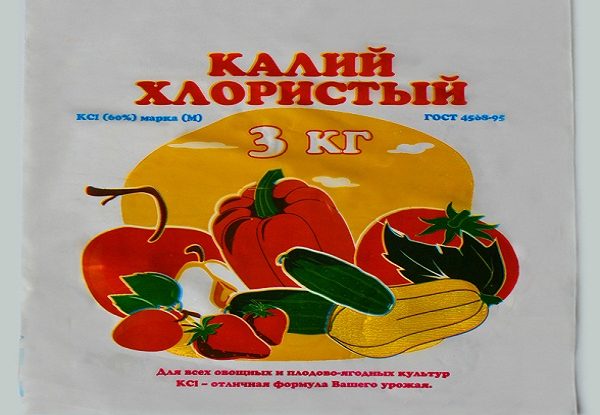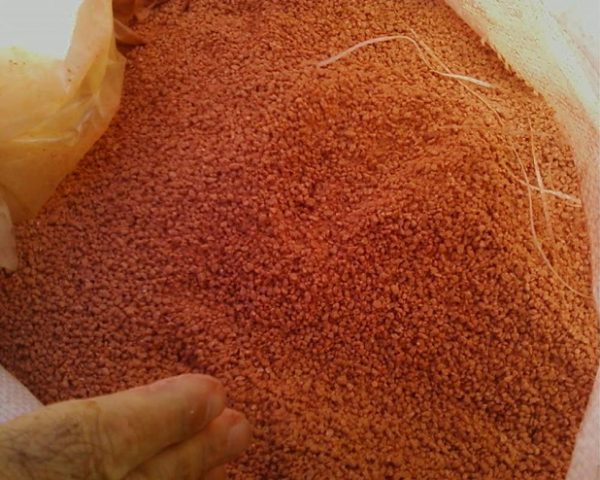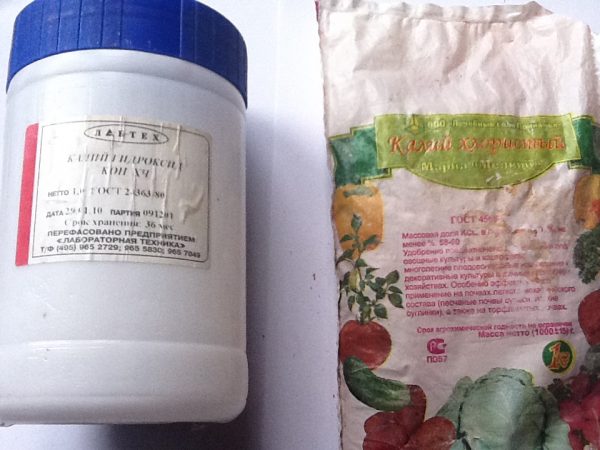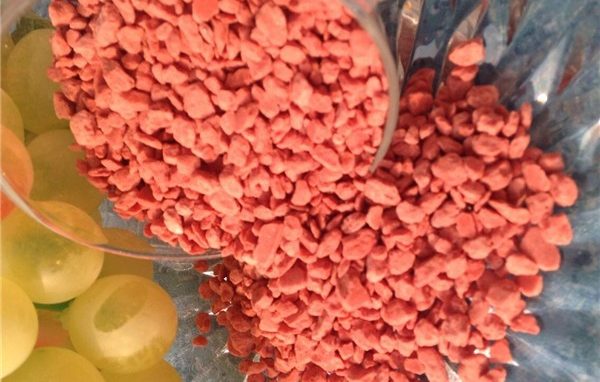Fertilizer potassium chloride: application and varieties
Content
What are the fertilizers
Potash preparations are divided into several types and subspecies, depending on the processing method and the content of the main component. By types of fertilizers are divided into: concentrated, complex, raw potash ores and industrial waste. Concentrated products include:
- Potassium chloride. Contains up to 65% pure substance. The advantages of the mixture include the maximum availability of elements for plants due to the combination of the main component with chlorine. The disadvantages include the presence of all the same chlorine, which immediately after application is harmful to many crops. Therefore, it is recommended to use chlorine only in the fall, so that it has time to evaporate and wash out with rains.
- Potassium sulfate. Contains about 50% of the main substance and about 20% of sulfur. It is considered the most effective for all types of crops, as it does not contain chlorine. It is used in spring as the main fertilizer immediately before planting vegetables and seedlings.
- Potassium salt. The basic substance contains approximately 40%. Suitable for all crops except those sensitive to chlorine. Salt is added to the soil in the fall when preparing the site for winter.
The most valuable in vegetable growing are complex preparations, which include:
- Potassium nitrate. The main substance is 38%, nitrogen - 13%, does not contain chlorine. It is considered the best supplement for greenhouse plants, but it can also be used outdoors when planting seedlings.
- Kalimagnesia. Contains up to 28% of the main substance and 16% of magnesium. It is well absorbed by plants, therefore it is often used as the main fertilizer, especially on sandy soils, and also as an emergency aid in case of a lack of magnesium.
- Nitrofoska. In addition to the main substance, it contains phosphorus and nitrogen. It is a universal remedy for most garden, fruit and berry crops, can be used on any soil.
Crude potash ores include salts obtained in the process of mechanical grinding of ore: sylvinite and kainite. These substances are distinguished by a relatively low content of the main component (10-18%), but at the same time they contain various impurities important for plants, as well as a chloride component in high concentration. Industrial waste includes cement dust and furnace ash, which are also highly valued:
- Cement dust. Contains up to 20% of pure potassium component, chloride is completely absent. Its use is most effective on acidic soils, as well as when growing potatoes.
- Ash. In addition to the main substance, it contains many useful elements: phosphorus, iron, copper, calcium, magnesium and others.It is the most affordable and economical tool for rural residents. It can be applied to any plant. It is introduced into the soil in the fall, and then in the form of solutions in the summer.
Video "Useful information about feeding"
An informative video providing useful information about potassium fertilization.
When to add potassium
Potassium preparations, undoubtedly have a positive effect on all plants. But, due to the fact that most of these products contain a chloride component, its use can harm some plants and soils. Fertilizing the soil with potassium chloride is recommended only in the fall and in a strictly limited amount, since chlorine is harmful to many garden crops. Long-term use of the drug negatively affects the condition of the soil - it can become acidic. In addition, potassium chloride contributes to the accumulation of salts in the soil.
Despite these disadvantages, fertilization with potassium chloride is indispensable on sandy, podzolic, peaty and sandy loam soils, where productivity is achieved only through the introduction of fertilizer mixtures.
There are also vegetables that, during the ripening process, absorb a lot of potassium substances, which leads to depletion of the soil. With a deficiency of potassium, plants become weak, their growth and development is impaired. You can determine the lack of potassium component in the soil by the appearance of the plants:
- leaves lose chlorophyll, become shriveled, reddish spots appear on them, the edges dry out and acquire a brown color;
- stems are weak, poorly developed, curved, pale colored;
- the root system is weak, poorly developed, which is why the plant is weakly fixed in the soil - it can be easily pulled out;
- fruits are small, long and poorly developed;
- the plants get sick, the greens are covered with various blooms.
Instructions for use
Before feeding plants with potassium chloride, it is recommended to carefully study the instructions - this will help to correctly calculate the required dosage. General recommendations for the use of potash preparations are as follows:
- dry mixes are embedded in the soil by mixing granules with wet soil;
- in the fall, fertilize the soil with potassium chloride should be at the rate of 100-200 g / 10 sq. m. area, for spring application the rate is 25-35 g / 10 sq. m .;
- potassium salt is applied to the soil for beets, carrots, cabbage, celery at the rate of 20-40 g / m. sq.;
- potassium sulfate is introduced for any crops in a dosage of 12-20 g / m. sq.;
- complex preparations are introduced into the soil at the rate of 15-20 g / m. sq., directly into the hole under the plant - 4-7 g / running meter;
- potash products are not recommended to be combined with chalk, lime, dolomites;
- when working with the substance, precautions should be taken: use a respirator, goggles and rubber gloves.
Plant compatibility
Potassium is necessary for all plants, but most of all for root crops: potatoes, sugar and table beets. At the same time, the fresh chloride component is harmful to most root crops, therefore, only potash preparations that do not contain chlorine are introduced before spring planting. They will contribute to the accumulation of starch and sugar in the tubers without harming the crops.
Fertilizing the soil with potassium chloride significantly increases the productivity of cereals: sunflowers, barley, millet. Wheat, rye, rice, buckwheat need relatively little of it. Complementary feeding with potassium preparations is necessary for ornamental garden plants and perennial flowers - introduced in the fall, they help the plants survive the winter safely. It is not recommended to fertilize crops sensitive to chlorine with potassium chloride:
- vegetables: cucumbers, tomatoes, potatoes;
- berry plants: gooseberries, currants, grapes, raspberries;
- legumes;
- salad cultures.
Potash feeding of these plants should be done with chlorine-free preparations.
Video "About tree fertilization"
Video review of the most commonly used fertilizers.





